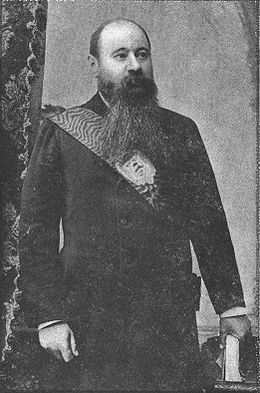Martinus Theunis Steyn
| Martinus Theunis Steyn | |
|---|---|
 | |
| 6th State President of the Orange Free State | |
| In office 4 March 1896 – 30 May 1902 | |
| Preceded by | Francis William Reitz |
| Succeeded by | Christiaan de Wet (acting) |
| Personal details | |
| Born | 1 October 1858 Winburg, Orange Free State |
| Died | 28 November 1916 (aged 58) Bloemfontein, Orange Free State Province, Union of South Africa |
| Political party | South African Party National Party |
| Alma mater | Grey College, Leiden University |
| Occupation | Lawyer |
| Religion | Dutch Reformed |
Martinus (or Marthinus) Theunis Steyn (1 October 1858 – 28 November 1916) was a South African lawyer, politician, and statesman, sixth and last president of the independent Orange Free State from 1896 to 1902.
Steyn was born at Winburg in the Orange Free State. After finishing his studies at Grey College, he went to the Netherlands where he studied law at Leiden University. Later he moved to England where he studied at the Inner Temple and was called to the English bar in November 1882. After his return to South Africa he set up practice as barrister in Bloemfontein. In 1889 Steyn was appointed state attorney of the Orange Free State. A few months afterwards he became second puisne judge, and in 1893 first puisne judge of the high court. His decisions won him a reputation for ability and sound judgment.
From early on, Steyn, along with many other prominent Freestaters, came under the influence of a clever German named Borckenhagen, editor of the Bloemfontein Express newspaper, and in 1881 he had joined Borckenhagen in founding the Afrikaner Bond.[1]
In 1895, upon the resignation of state president F.W. Reitz, Steyn was the candidate of the pan-Dutch party for the vacant post. The election was held in February 1896 and resulted in a decisive victory for Steyn, and he assumed office as president. The beginning of the South African War (Second Boer War) in 1899, caused Steyn to link the fortunes of his state with those of the Transvaal, allying with them against the British Empire. While the Orange Free State was under British occupation, Steyn ran his government from the field, playing a key role in continuing Boer resistance and the coordination of guerrilla warfare that made up most of the Boer War from 1900 onwards.
Regarded as one of the most irreconcilable of the Boer leaders, he took part, however, in the preliminary peace negotiations at Klerksdorp in April 1902, but was prevented by illness from signing the Treaty of Vereeniging at Pretoria on 31 May. The treaty ended the independence of the Orange Free State and Steyn's term as its president. By 1902 Steyn was suffering from myasthenia gravis brought on by his constant exertions; and in July 1902 he sailed for Europe, where he remained until the autumn of 1904.
He then took the oath of allegiance to the British crown, and returning to South Africa partially restored to health resumed an active participation in politics. In 1908–1909 he was vice-president of the Closer Union Convention, where he was distinguished for his statesmanlike and conciliatory attitude, while maintaining the rights of the Boer community. In the South African Union he was a co-founder of the South African Party which he left in 1914 with James Barry Munnik Hertzog and Christiaan Rudolf de Wet to found the National Party.
While addressing a meeting in Bloemfontein in November 1916, he collapsed and died of a heart attack, he was only 58 years old.
Steyn has a descendant who practises as a lawyer in Johannesburg. His granddaughter was the well-known South African actress Nerina Ferreira.[2]
Quote
"I would rather lose the independence of the Free State with honour than retain it with dishonor". Stated before he dispatched the ultimatum (starting the Anglo-boer War) to the United Kingdom.
References
- ↑ http://en.wikisource.org/wiki/Page:EB1911_-_Volume_20.djvu/183
- ↑ "Nerina Ferreira verskyn weer op die Verhoog" (June 1, 1969) Die Burger, Cape Town
External links
| Wikimedia Commons has media related to Martinus Theunis Steyn. |
| Wikisource has original text related to this article: |
| ||||||||||||||
 This article incorporates text from a publication now in the public domain: Chisholm, Hugh, ed. (1911). Encyclopædia Britannica (11th ed.). Cambridge University Press
This article incorporates text from a publication now in the public domain: Chisholm, Hugh, ed. (1911). Encyclopædia Britannica (11th ed.). Cambridge University Press
